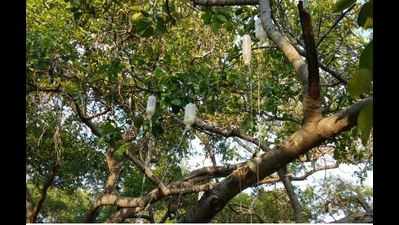- News
- City News
- Hyderabad News
- Pillalamarri, the great banyan tree in Telangana, is on deathbed
Trending
This story is from May 22, 2018
Pillalamarri, the great banyan tree in Telangana, is on deathbed

Harmful chemical chlorpyrifos was “injected” into the branches through “saline bottles”
HYDERABAD: Pillalamarri, the great banyan tree in Mahbubnagar, is virtually on deathbed. Notwithstanding the claims of officials that the recent 'injection' of chlorpyrifos has rejuvenated the 700-year-old tree, the trunks have been eaten away by white ants. Decades of neglect by officials concerned has made quite miserable the life of one of the largest and oldest trees in the world.In fact, the use of chlorpyrifos without a pilot research on the banyan may prove to be harmful to the tree itself.
A closer inspection of the trunks of Pillalamarri reveals a high level of infestation by termites or white ants. Not only the trunk but also branches are infested. Some of them have turned hollow while a few branches are in different stages of withering. Even the banyan trees outside the compound of Pillalamarri are infested by white ants.
District and forest officials have launched several measures to keep the grand old banyan tree alive, but the efforts came too late. Harmful chemical chlorpyrifos was “injected” into the branches through “saline bottles” with tubes without conducting a scientific study on the harmful impact of chlorpyrifos on the banyan tree and the teeming lifeforms it supports.
Forest officials claim that the tree is generating new foliage following chlorpyrifos treatment as the insecticide has killed the termites. They stopped the saline treatment on most of the branches though a few still gets the “saline bottles” feed. According to experts, the insecticide may have controlled the termite infection to certain extent, but the damage it would cause to the banyan tree itself, birds, beneficial insects and small mammals is irreparable.
A recent study negated the popular belief among botanists that chlorpyrifos being an insecticide is not harmful to trees. However, it has been proved that chlorpyrifos would adversely affect many tree species. The chemical does also kill other animal species besides the pest. It could also affect non-target species like domestic animals like dogs and cats and even human beings as chlorpyrifos tends to stay in the plant tissue for long.
Researchers have showed that chlorpyrifos and its metabolites harm the trees by inhibiting an enzyme called cholinesterase. It also adversely affects other enzymes in the plant tissue. It will lead to limited uptake of nutrients from the soil. Some of the harmful results of chlorpyrifos on trees are delay in germination, malformation of fruits and flowers, and abnormal division of cells.
Pillalamarri, one of the five great banyans in India, is spread over 3.5 acres. With prop roots growing all over the compound it is difficult to identify the mother tree.
A closer inspection of the trunks of Pillalamarri reveals a high level of infestation by termites or white ants. Not only the trunk but also branches are infested. Some of them have turned hollow while a few branches are in different stages of withering. Even the banyan trees outside the compound of Pillalamarri are infested by white ants.
District and forest officials have launched several measures to keep the grand old banyan tree alive, but the efforts came too late. Harmful chemical chlorpyrifos was “injected” into the branches through “saline bottles” with tubes without conducting a scientific study on the harmful impact of chlorpyrifos on the banyan tree and the teeming lifeforms it supports.
Forest officials claim that the tree is generating new foliage following chlorpyrifos treatment as the insecticide has killed the termites. They stopped the saline treatment on most of the branches though a few still gets the “saline bottles” feed. According to experts, the insecticide may have controlled the termite infection to certain extent, but the damage it would cause to the banyan tree itself, birds, beneficial insects and small mammals is irreparable.
Research studies conducted elsewhere revealed that chlorpyrifos is taken up by trees as a nutrient solution leading to accumulation of significant amounts of the harmful chemical in the plant tissue. The roots showed high accumulation of chlorpyrifos. The shoots, however, showed relatively low levels of the chemical.
A recent study negated the popular belief among botanists that chlorpyrifos being an insecticide is not harmful to trees. However, it has been proved that chlorpyrifos would adversely affect many tree species. The chemical does also kill other animal species besides the pest. It could also affect non-target species like domestic animals like dogs and cats and even human beings as chlorpyrifos tends to stay in the plant tissue for long.
Researchers have showed that chlorpyrifos and its metabolites harm the trees by inhibiting an enzyme called cholinesterase. It also adversely affects other enzymes in the plant tissue. It will lead to limited uptake of nutrients from the soil. Some of the harmful results of chlorpyrifos on trees are delay in germination, malformation of fruits and flowers, and abnormal division of cells.
Pillalamarri, one of the five great banyans in India, is spread over 3.5 acres. With prop roots growing all over the compound it is difficult to identify the mother tree.
End of Article
FOLLOW US ON SOCIAL MEDIA











